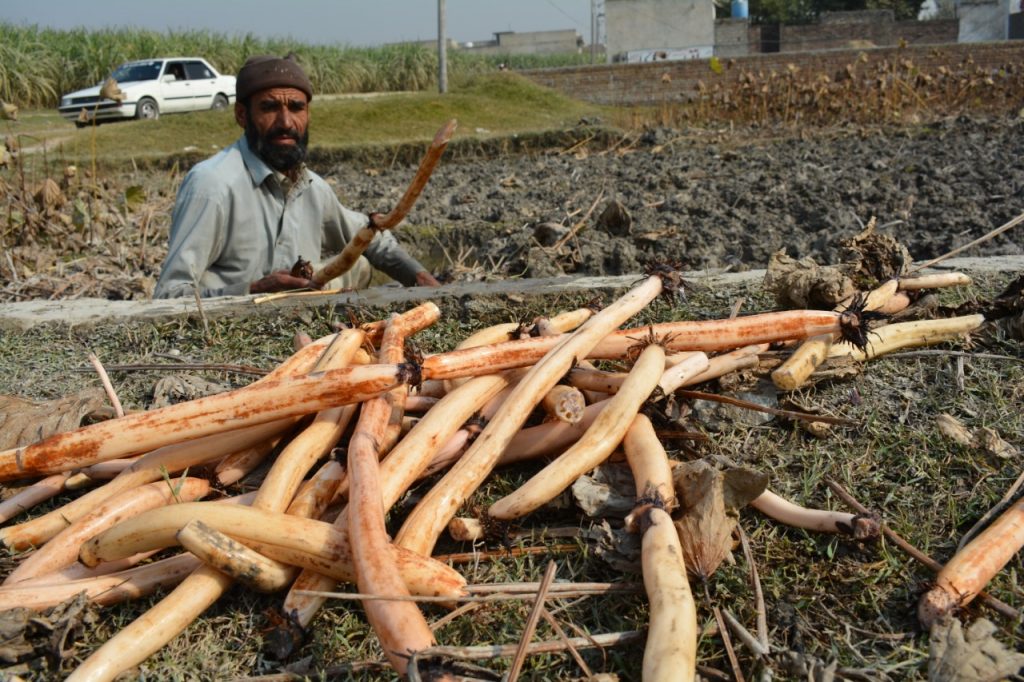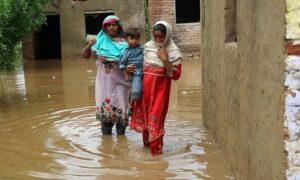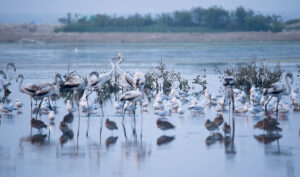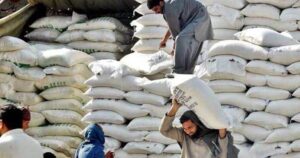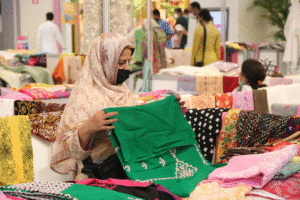Fifty-year-old Bakht Munir begins the harvest season on his 20-acre farm in Charsadda, where for years, he has only cultivated brsandi, a local vegetable. His fields remain submerged under water throughout the year, and the heavy rains this season have dashed his hopes for a good harvest. Despite these challenges, Bakht has no choice but to continue growing the crop—his only option, as no other vegetable can survive the waterlogged conditions.
“Every year, I hope for better weather, but with the water constantly sitting on my fields, I can’t plant anything else,” Bakht says, wiping sweat from his brow as he watches his laborers pull the muddy brsandi from the ground.
The Aftermath of Industry Shutdowns
Bakht’s plight is shared by hundreds of farmers in Charsadda, an agricultural heartland in Khyber Pakhtunkhwa. The region’s fertile lands are situated between the Jindi River and two now-defunct sugar and paper mills. When these mills were operational, they consumed vast quantities of water, keeping the surrounding water table in check.
ALSO READ:
Khyber Pakhtunkhwa Government Launches Multi-Pronged Climate Change Initiative
Amjad Ali, another farmer, recalls the days when these mills supported both the local economy and the agricultural ecosystem. “The mills used to pump water from the ground, allowing us to grow wheat, maize, and sugarcane. But after they closed in the 1990s, the water levels rose, and the fields became swampy,” he says. “Now, all we can grow is brsandi.”
With over 2,000 acres of land now submerged, brsandi—a root vegetable that thrives in wet conditions—has become the lifeline for farmers in the area. However, the crop offers only modest returns and involves backbreaking labor.
Laborers’ Struggles: Hard Work for Little Pay
Harvesting brsandi is no easy task. Rohullah, a seasonal laborer, spends six months of the year in the fields. “We work from eight in the morning until two in the afternoon and earn just 500 rupees a day,” he says. “It’s barely enough to survive.” He explains that brsandi grows two to four feet deep in the soil, and laborers must dig through mud and water to extract it.
The job is especially grueling in the winter months. “It’s freezing, and we don’t have proper tools or clothing. But what choice do we have?” Rohullah asks, his hands cracked from the cold and covered in mud. On a good day, a laborer can harvest 10 to 15 kilograms of the vegetable, which is sold to middlemen for around 2,500 rupees for 40 kilograms.
ALSO READ:
Water Crisis Threatens Peshawar’s Future
A Niche Market for a Unique Crop
In Peshawar’s Ghanta Ghar market, Wajid Ali has been selling vegetables for over a decade. He explains that unlike other produce, brsandi doesn’t go through the usual wholesale markets. Instead, middlemen sell it directly to vendors.
“Once we buy it, we sort it into large and small sizes. The larger pieces sell for 200 rupees per kilogram, while the smaller ones go for 150,” Wajid says. “It’s not like the usual vegetables you find in the market—it’s got a niche following. Some people use it for curries, while others even make fritters out of it.”
Despite its limited market, brsandi remains a crucial source of income for the farmers of Charsadda.
Government Inaction and Traditional Solutions
For years, the farmers in this region have struggled without any formal support from the government. The Khyber Pakhtunkhwa Agriculture Department reports that over 1.3 million acres of land across the province have become unusable due to stagnant water, floods, and pollution. Efforts to reclaim some of this land have begun, but they are slow and inadequate. Meanwhile, local farmers rely on traditional methods to save their crops from diseases and pests.
“When a plant gets sick, we take the leaves or roots to the local shop and ask for advice on what chemicals to use,” Bakht Munir explains. “But it’s expensive, and the diseases are getting worse every year.”
The floods in 2010 devastated the region, leaving many fields barren for years. Since then, pests have become a major issue, forcing farmers to spend thousands of rupees on pesticides each year. Still, the crops remain fragile, vulnerable to diseases, and easily damaged by strong winds.
A Glimmer of Hope?
Despite the challenges, Bakht Munir remains hopeful for the future. He recalls how 20 years ago, he brought brsandi seeds from Punjab’s Jehlum district to plant in his flooded fields. “It was the only crop that could survive here, and soon, other farmers followed my lead. We revived thousands of acres that had been left barren.”
Looking ahead, Bakht believes that if the government could launch a project to reduce the water levels, the region’s farmers could once again grow more lucrative crops. “If we could lower the water table, we could plant wheat, sugarcane, and maize like we used to,” he says.
Until then, Bakht and his fellow farmers continue to harvest brsandi, fighting the elements and relying on a crop that’s both a blessing and a curse.

